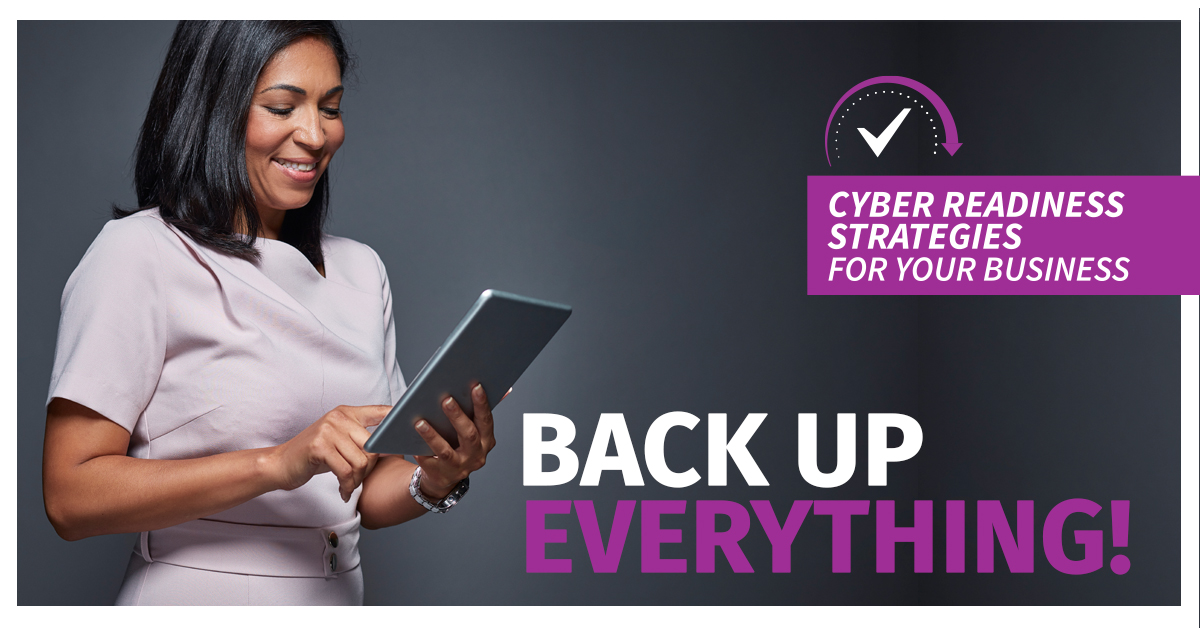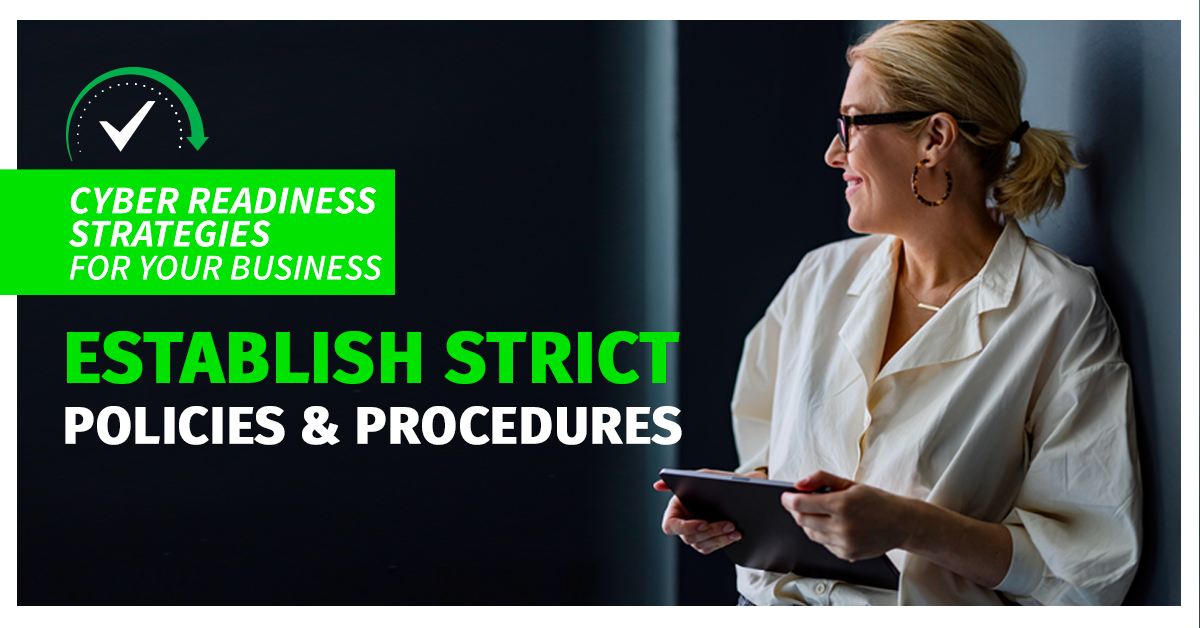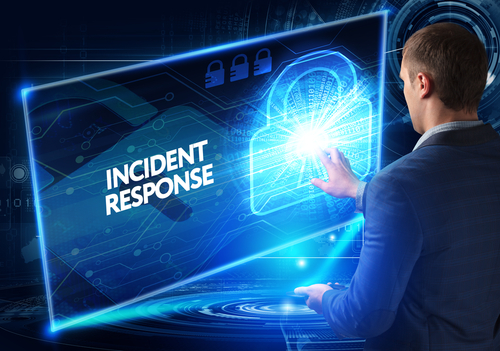Why Compliance is Essential for a Cyber-Ready Business
It’s more important than ever to maintain regulatory compliance. Many industries, such as healthcare and finance, are required to comply with strict data protection regulations. Non-compliance can result in hefty fines, legal action, and reputational damage. However, achieving compliance can be complicated and stressful. Here are five reasons why you shouldn't neglect compliance in your business:
- Protects sensitive data: Compliance regulations are designed to protect sensitive data from unauthorized access, theft, or exposure. Compliance requirements ensure that businesses have appropriate security measures in place to safeguard sensitive data.
- Builds customer trust: Compliance with data protection regulations can help build customer trust. Customers want to know that their sensitive data is safe and that businesses take their privacy seriously.
- Avoids legal action: Non-compliance can result in legal action, which can be costly and time-consuming. In some cases, businesses may even face criminal charges for non-compliance.
- Mitigates reputational damage: Non-compliance can damage a business's reputation. This can have a long-lasting impact on the business's bottom line, as customers may lose trust in the company and take their business elsewhere.
- Improves cybersecurity posture: Compliance regulations often require businesses to implement robust cybersecurity measures. This can improve a business's overall cybersecurity posture and reduce the risk of cyber attacks.
Navigating and satisfying compliance obligations can be challenging, but it's essential to have a cyber-ready business. The good news is that there are experts who can take the stress out of compliance for your business. These experts can help you understand your compliance requirements, develop a compliance strategy, and implement appropriate security measures to protect sensitive data.
We understand how important it is that compliance is not something to be neglected. Achieving compliance is a critical component of having a cyber-ready business. Compliance protects sensitive data, builds customer trust, avoids legal action, mitigates reputational damage, and improves a business's cybersecurity posture. Don't neglect compliance - let us take the stress out of compliance for your business.
3-2-1 Backup Strategy: Protect Your Business Data
With data security threats and risks continuing to increase, it is essential for businesses to have a robust data backup system in place. The 3-2-1 method of backups provides companies with a reliable way to ensure their valuable data is protected and accessible. In this blog, we'll discuss why the 3-2-1 strategy is important and how you can put it into practice for your business.
What is the 3-2-1 Backup Strategy?
The 3-2-1 strategy requires that businesses maintain three copies of their data—one primary copy, two local copies, and one offsite copy. This means that if something happens to your primary copy of data, you have two redundant backups available to you onsite and an extra offsite backup in case of a major disaster or catastrophic event.
Having multiple copies of your data allows you to quickly recover lost information or access it from other locations should the need arise. Additionally, having multiple versions of your data stored in different places helps protect against malicious attacks or human error which can cause irreparable damage to your business’s sensitive information.
Why Use Identity & Access Management?
Identity & Access Management (IAM) software can help protect against cyber threats by providing secure access control and authentication for all users who interact with your organization’s systems. IAM solutions provide visibility into user activity across all applications, networks, devices and databases so that suspicious activity can be quickly identified and blocked before any damage occurs. Additionally, IAM solutions also provide detailed reports on who accessed what information when; ensuring total accountability over all user activity associated with sensitive data within an organization’s network infrastructure. This helps organizations remain compliant with industry regulations while providing them with peace of mind knowing that their systems are securely protected against potential cyber threats.
Protecting your business's valuable data is essential in today's digital age where cyber threats are increasing every day. The 3-2-1 backup strategy provides businesses with a reliable way to ensure their data is safe while identity & access management solutions provide an additional layer of security by restricting access to sensitive network resources based on user roles and privileges assigned by IT administrators. By following these best practices, businesses can rest assured that their valuable corporate assets are safe from would be attackers or malicious insiders intent on doing harm.
Boost Your Cybersecurity with Force Authentication: Why One-Level Security is No Longer Enough
As businesses continue to digitize their operations, the need for reliable security measures becomes more important than ever. One of the biggest concerns is the protection of sensitive data from unauthorized access. Unfortunately, relying on a single method of authentication is no longer sufficient. Hackers and cybercriminals are becoming more sophisticated, and even the strongest passwords can be easily breached.
To mitigate the risks associated with stolen or exposed credentials, businesses need to adopt multi-factor authentication solutions. Identity and access management (IAM) is the process of managing user identities and controlling access to sensitive information. By implementing IAM, businesses can ensure that only authorized users can access their systems and data.
Here are five ways that IAM can improve your organization's security posture:
- Protects against phishing attacks: Phishing attacks are one of the most common methods used by cybercriminals to gain access to sensitive information. IAM solutions can provide an additional layer of protection by requiring users to provide a second factor of authentication, such as a fingerprint scan or a code sent to their phone.
- Enhances compliance: Many industries, such as healthcare and finance, are required to comply with strict data protection regulations. IAM solutions can help ensure that access to sensitive data is restricted only to authorized personnel, thereby reducing the risk of non-compliance.
- Reduces password-related risks: Passwords are one of the weakest links in cybersecurity. IAM solutions can eliminate the risks associated with weak passwords by requiring users to provide additional authentication factors.
- Provides centralized access control: IAM solutions allow businesses to manage user identities and access permissions centrally, thereby reducing the risks associated with decentralized access control.
- Facilitates remote access: With the rise of remote work, the need for secure remote access has become more critical. IAM solutions can provide secure remote access to corporate networks and resources while ensuring that only authorized users can access them.
The risks associated with stolen or exposed credentials are too significant to ignore. By implementing IAM solutions, businesses can ensure that their sensitive data and systems are protected against unauthorized access. The benefits of IAM go beyond just security, as it can also improve compliance, reduce password-related risks, provide centralized access control, and facilitate secure remote access.
Don't wait until it's too late - get cyber ready with identity and access management today.
Why System Updates and Patches are Essential for Cyber Security
As technology advances, so do the risks associated with it. Keeping your business’s systems and software up-to-date is essential to ensuring that you are cyber ready. Updates often introduce new or enhanced features into your apps, programs and systems, but they also install security and performance fixes known as patches. These patches fix any undetected defects or flaws in the system which can leave your systems exposed if not addressed. Hackers will exploit any vulnerability or security gap they find. In this blog post, we will discuss why updates and patches are so important for maintaining a secure system.
The Importance of System Updates
System updates ensure that all of the software on your computer is up-to-date with the latest security patches and bug fixes from their respective developers. Installing these updates provides protection from malicious security threats such as viruses, worms, Trojans, spyware and other malware. It also helps protect against zero-day attacks where hackers take advantage of newly discovered vulnerabilities before they have been patched by developers. Additionally, installing updates can improve the performance of your system by increasing speed and efficiency while reducing errors caused by outdated software versions.
Securing Your Data
Data is one of the most valuable assets to any business, so protecting it should be a top priority when it comes to keeping your system cyber ready. By regularly installing updates and patches you can help protect sensitive data from being accessed by unauthorized individuals or malicious actors online. Updates can include improved data encryption algorithms which make it harder for hackers to access sensitive information stored on your computers or servers even if they manage to penetrate your network security defenses. It also ensures that any existing vulnerabilities in the software are closed off which prevents attackers from exploiting them to gain access to sensitive data or networks.
Keeping Up With Technology
Technology is constantly changing and evolving, so staying ahead of the curve is essential in order to keep up with security trends and best practices for protecting yourself against cyber threats. Installing regular updates on all devices helps ensure that all components within the network are running the most recent version of their respective applications which helps reduce potential attack surfaces since outdated versions may contain known vulnerabilities that have already been fixed in newer releases. Additionally, staying up-to-date with technology can give you a competitive edge over competitors who may not be as proactive when it comes to keeping their systems updated with the latest security patches and bug fixes available from developers.
Keeping your systems updated is vital for keeping your business cyber ready; however, while updates often introduce new or enhanced features into apps programs and systems, they also install security and performance fixes known as patches which address undiscovered defects or flaws in the system that can leave them vulnerable to attacks from malicious actors online. Installing regular updates keeps data safe from unauthorized access while ensuring that all components within a network are running using only the most recent version available from developers—helping protect against zero day attacks before they happen—and providing businesses with an edge over competitors who may not be as proactive when it comes to cybersecurity best practices. By staying ahead of technology trends—with regular updates—businesses can maintain a secure system while avoiding potential risks associated with outdated software versions leaving them better prepared for whatever lurks around every corner online!
Don’t wait until it’s too late – prioritize your cyber readiness today.
Cyber Security: Establishing Strict Policies and Procedures
In this article about Cyber Security Readiness, we will explore the importance of establishing strict policies and procedures in a workplace and provide examples of effective protocols that can help companies safeguard their operations.
Why Establish Strict Policies and Procedures?
Establishing policies and procedures is crucial for ensuring that businesses operate effectively and efficiently. By setting clear expectations and guidelines for employee behavior and actions, companies can create a work environment that promotes consistency, transparency, and accountability.
Strict policies and procedures also help companies to reduce the risk of security breaches, data leaks, and other security incidents. By implementing secure protocols and processes, companies can safeguard their operations and protect their sensitive information from cyber threats.
Examples of Effective Policies and Procedures
Password Policies
One of the most effective ways to safeguard against cyber threats is to implement a robust password policy. This policy should include guidelines for creating secure passwords, such as using a combination of letters, numbers, and symbols, and changing passwords regularly. Companies can also implement two-factor authentication to add an extra layer of security.
Employee Code of Conduct
A code of conduct is a set of rules and guidelines that outline expected behavior for employees. This policy should cover topics such as professionalism, ethics, and confidentiality. By clearly defining expectations for employee behavior, companies can promote a positive work environment and minimize the risk of legal and ethical violations.
Data Protection Policies
Data protection policies are essential for safeguarding sensitive information, such as customer data, financial records, and intellectual property. These policies should outline the steps employees must take to protect data, such as encrypting files, limiting access to sensitive information, and reporting any security incidents promptly.
Incident Response Plan
An incident response plan is a protocol that outlines the steps employees must take in the event of a security incident. This plan should include procedures for identifying the incident, containing the damage, and reporting the incident to the appropriate authorities. By having an incident response plan in place, companies can minimize the impact of security incidents and reduce downtime.
Remote Work Policies
Remote work policies are becoming increasingly important as more companies embrace flexible work arrangements. These policies should outline the guidelines and expectations for remote workers, such as work hours, communication protocols, and security requirements. By implementing strict remote work policies, companies can maintain productivity and protect their operations from cyber threats.
In conclusion, establishing strict policies and procedures is essential for regulating business operations and safeguarding against security threats. Companies must prioritize security-focused protocols and processes to protect their sensitive information and reduce the risk of security incidents. By implementing effective policies and procedures, companies can promote consistency, transparency, and accountability in the workplace.
Potential Financial Scams to Watch Out For In Light of Recent Bank Failure
As we continue to navigate through the complexities of the financial world, it's essential to be aware of potential scams and fraudulent activities that can compromise our finances and personal information. Unfortunately, even the most reputable financial institutions can fall prey to cybercriminals, and as such, it's crucial to stay vigilant and informed.
In light of recent bank failures, scammers have taken advantage of this situation to launch various fraudulent activities. Below are some potential scams to be aware of:
Recovery Scams: Scammers may pose as the failed bank or another reputable financial institution and offer to help customers recover their lost funds in exchange for a fee or sensitive company and/or personal information. These fraudsters are known to prey on vulnerable individuals who may be desperate to recover their lost funds, and they often use sophisticated tactics to convince their victims that they are legitimate.
Payment Scams: Scammers may send fake emails changing the process to make payments on open invoices to a new bank. These fraudulent activities may seem legitimate, with scammers impersonating authorized personnel and providing detailed instructions on how to ma
Information Gathering Scams: Fraudsters may send fake emails, texts, or phone calls to customers claiming to be from the failed bank and asking for sensitive information such as passwords, account numbers, or social security numbers. These scammers may use various tactics to obtain the customer's trust before requesting sensitive information, which they use to steal funds or engage in identity theft.
Charity Scams: Scammers may also use the bank failure as an opportunity to solicit donations for a fake charity or relief fund, claiming to help those affected by the bank's collapse. These fraudulent activities often involve unsolicited emails, phone calls, or text messages, and they may use emotional appeals to convince individuals to donate.
Phishing Scams: There may be an increase in phishing scams, where fraudsters send emails or texts that appear to be from the bank or another financial institution, asking customers to click on a link or download an attachment that installs malware on their device. These scams can compromise the security of personal information, making it essential to be cautious when clicking on links or downloading attachments.
It's important to remember that legitimate financial institutions will never ask for sensitive information or payment in exchange for helping customers recover lost funds. If customers receive any suspicious communications, they should contact their CFO/Controller, CPA/Accountant or directly contact the financial institution through a trusted channel, such as the official website or phone number, to verify any changes before sending any funds or divulging and sensitive information.
By staying informed and vigilant, we can protect ourselves from potential financial scams and fraudulent activities, ensuring that our finances and personal information remain secure.
6 Essential Steps to Create a Cyber Readiness Plan for Your Business | Expert Tips and Best Practices
With the increasing digitization of businesses and the proliferation of digital tools and technologies, cybersecurity has become a critical issue that can no longer be ignored. Cyberattacks and security breaches are a constant threat that can compromise the success and survival of businesses of all sizes and industries. As a business owner or leader, it's essential to take risks seriously and develop a cyber readiness plan that includes prevention, continuity, and recovery strategies. In this article, we'll discuss some essential tips and strategies that can help you safeguard your business against cyber threats and stay ahead of the game.
- Conduct a thorough risk assessment: The first step in developing a cyber readiness plan is to identify potential risks and vulnerabilities that could impact your business. This includes conducting a thorough risk assessment of your IT systems, networks, and applications. This will help you understand your current cybersecurity posture and identify areas that need improvement.
- Implement strong access controls: One of the most effective ways to prevent cyber attacks is to limit access to critical data and systems. Implementing strong access controls such as two-factor authentication, password policies, and role-based access can help ensure that only authorized personnel can access sensitive data.
- Invest in cybersecurity tools and technologies: There are several cybersecurity tools and technologies available that can help you protect your business from cyber threats. These include firewalls, antivirus software, intrusion detection and prevention systems, and endpoint protection solutions. Investing in these tools can provide an additional layer of protection to your IT systems and networks.
- Develop an incident response plan: Despite taking all necessary precautions, a cyberattack or security breach can still occur. That's why it's crucial to have an incident response plan in place that outlines the steps to take in case of a security incident. This should include steps for containing the incident, notifying relevant stakeholders, and recovering from the incident.
- Regularly train employees: Employees are often the weakest link in an organization's cybersecurity posture. That's why it's essential to regularly train them on cybersecurity best practices and how to recognize and report suspicious activity. This can help prevent human errors that could lead to a security breach.
- Conduct regular audits and testing: Regularly auditing and testing your IT systems and networks can help you identify potential vulnerabilities and weaknesses that could be exploited by cybercriminals. This can include penetration testing, vulnerability assessments, and compliance audits.
In conclusion, cybersecurity is a critical issue that businesses can no longer afford to ignore. Developing a cyber readiness plan that includes prevention, continuity, and recovery strategies can help you safeguard your business against cyber threats and ensure your long-term success and survival. By implementing the tips and strategies discussed in this article, you can stay ahead of the game and protect your business from cybercriminals.
To start building your cyber readiness plan, contact us today.
Don’t forget your phone when you think about cyber security
Our phones are a goldmine of private information. Just think of all the financial details, personal messages, banking apps, photos and contact information that live behind that little glass screen.
And if your team use phones for work, they’ll often have access straight into company systems – email, contact lists, network access, file systems. So if they’re not kept as secure as any other device in your workplace, they can become a gaping hole in your cyber security.
Criminals know this, of course, which is why they target us through our phones just as much as they do through our networks and servers.
But cyber crime isn’t the only concern. Just losing your phone, or having it stolen, can put your data at huge risk.
So, whether you issue company smartphones, or your employees use their own, you should make sure everyone implements some simple security steps to protect your data and avoid disaster.
Start with making sure your people set up a PIN and a biometric login (like a fingerprint or face scan) to open the device.
Only install apps from trusted sources to make sure you’re using genuine software.
And enable Multi-Factor Authentication on all apps that store even a small amount of sensitive data.
Be careful about where you connect to Wi-Fi. If you work remotely or often connect to public networks, consider using a VPN – a Virtual Private Network – to add another layer of security. You never know who’s monitoring traffic on a public network.
Finally, ALWAYS make sure your phone is running the latest version of its operating software, and keep all apps up to date.
Smartphones have changed so much about the way we live – at home, and at work – but it’s too easy to take them for granted. And that could be a costly mistake.
If you need help to keep your smartphones safe, just get in touch.
98% of Businesses Have Risky Cloud Configurations Issues
Are you leveraging the cloud to run your business operations? If so, then you're not alone — over 98% of businesses are using the cloud for workloads, enterprise resource planning systems and more. Unfortunately, many organizations have overlooked one crucial element: their cloud configurations. Contrary to popular belief, there is a real risk associated with misconfigured cloud environments. Incomplete or inaccurate configuration settings can create vulnerabilities that lead to data leaks and other security incidents that can negatively impact your organization and its reputation. Keep reading to find out how it happens and what steps you can take to protect yourself from potential disaster.
Cloud technologies are a revolution in cloud computing, enabling businesses to access enterprise-level network applications and computing platforms without physical servers or hardware taking up space. These cloud systems provide round the clock service with efficiency and minimal effort, but they are not without certain risks. According to recent data, 97% of cloud infrastructures have at least one misconfiguration setting, leaving them vulnerable to potential threats like data leaks, identity theft and malicious attacks. This highlights the importance of proper cloud security measures and demonstrates why cloud technology can be such a powerful tool if done correctly.
Misconfigured cloud technologies can be a real danger for many companies and organizations in today's digital world; if the proper protocols, firewalls, and security measures are not sufficiently put in place, the data stored on them can become vulnerable to exploitation. Without these safeguards, companies take the risk of their data becoming compromised and hackers impacting their operations or causing irreparable damage to their network, such as:
Data breaches
One of the most serious outcomes that can arise from misconfigured cloud technologies is a data breach. A data breach occurs when sensitive or confidential information is released to unauthorized individuals. A data breach can have a number of devastating consequences, including financial loss, damage to reputation, and loss of customer trust.
Compliance issues
Another possible outcome of misconfigured cloud technologies is compliance issues. Organizations that use cloud technologies are subject to a variety of regulations, such as the Sarbanes-Oxley Act and the Health Insurance Portability and Accountability Act. If cloud technologies are not configured properly, it could result in an organization failing to meet its compliance obligations, which could lead to hefty fines or even jail time for executives.
Poor performance
In addition to the potential for data breaches and compliance issues, misconfigured cloud technologies can also lead to poor performance. When cloud technologies are not configured properly, it can result in slow response times, downtime, and other technical problems. Poor performance can lead to a loss of productivity and revenue for an organization.
Another potential outcome of misconfigured cloud technologies is security vulnerabilities. If cloud technologies are not configured properly, it could leave an organization's systems and data open to attack from hackers or other malicious actors. This could result in a loss of confidential information, damage to reputation, and financial loss.
Increased costs
Finally, another possible outcome of misconfigured cloud technologies is increased costs. When cloud technologies are not configured properly, it can lead to wasted resources, such as storage space or computing power. This can ultimately lead to higher costs for an organization. With technology playing an integral role in business success, there is no denying its importance. Knowing the risks associated with different tech solutions is critical to ensure your business remains secure and compliant. It's important to work with a trusted partner who understands the complexity of the tech landscape and solutions which can protect you from risk.
At Tru Technical Partners, we have the expertise in security and compliance to make sure you're always taking advantage of new opportunities while not putting yourself at risk. Plus, our team can help prevent any potential reputational damage due to a data breach or cybersecurity incident. Let us help you create reliable IT solutions that will maximize value while minimizing risk into the future. Contact our team today and get started on creating robust IT systems to protect your business operations – and give yourself peace of mind moving forward!
Let’s start talking about AI
The whole world is suddenly talking about Artificial Intelligence.
From Alexa in your kitchen, to Siri on your phone, AI is already all around us, but new names like ChatGPT, Dall-E, Jasper and more feel like they’ve blown up the internet.
These new concepts take things WAY further, helping us to write articles, search the web with natural conversation, generate images, create code, and introduce new ways to make our daily lives even easier.
But emerging technology nearly always launches in a blizzard of geek-speak before it settles into everyday life. Early PC users might remember the ‘DOS prompt’. And when did you ever have to ‘defrag’ your phone?
Experts believe that these new AI tools will become the building blocks of a whole new world of tech, redefining the way we interact with computers and machines.
So let’s help you decode some of the terms you’ll hear this year.
Chatbot Starting with the basics, a chatbot is an app that mimics human-to-human contact. Just type or speak normally, and the chatbot will respond the same way. ChatGPT is a chatbot. If you haven’t tried it out yet, give it a go.
Deep learning This is the technique that’s used to imitate the human brain, by learning from data. Current search tools and systems use pre-programmed algorithms to respond to requests. AI tools are trained on concepts and conversations in the real-world, and learn as they go to provide human-like responses.
Machine intelligence The umbrella term for machine learning, deep learning, and conventional algorithms. “Will machine intelligence surpass human ingenuity?”
Natural Language Understanding (NLU) helps machines understand the meaning of what we say, even if we make grammatical errors or speak with different regional accents.
Weak AI is the most common form of AI in use right now. Weak AI is non-sentient and typically focuses on a single or small range of activities – for instance writing, or repurposing video content. Strong AI, on the other hand has the goal of producing systems that are as intelligent and skilled as the human mind. Just not yet.
This is just the tip of the iceberg, but trust us – you’re going to be hearing a lot more about AI in the months and years to come.
If you’d like more help to understand how AI might form part of your business, just get in touch.
Cyber attacks are getting bigger and smarter. Are you vulnerable?
Have you ever tried to buy tickets for a huge event and found that the seller’s website has collapsed under the weight of thousands of people all trying to do the same thing at the same time?
The ticket site falls over – usually temporarily – because the server is overloaded with traffic it doesn’t have the capacity for.
Criminal Distributed Denial of Service attacks – DDoS, for short – exploit the same principle.
When a DDoS attack targets a business, it floods it with internet traffic in an attempt to overwhelm the system and force it to fail.
This results in the business and its customers being unable to access services. That may trigger a temporary failure, or it could be more serious. Last year, the average DDoS attack lasted 50 minutes.
That may not sound like a long time, but it’s enough to create angry customers, or to bring business to a grinding halt. And downtime can be costly.
The really bad news is that DDoS attacks are not only lasting longer, but they’re becoming bigger, more sophisticated and more common.
Recently, the biggest ever reported DDoS attack was reportedly blocked. At its peak, it sent 71 million requests per SECOND to its target’s servers. Prior to that, the biggest reported incident stood at 46 million requests per second.
Worse still, more businesses are reporting being targeted by DDoS attacks where criminals are demanding huge ransoms to stop the attack.
What does this mean for you?
It’s important you check all your security measures are up-to-date and working as they should be. Are your firewalls up to the task, with DDoS monitoring and prevention tools set up? And is your team fully aware of the importance of staying vigilant?
We can help make sure your business stays protected. Just get in touch.
Published with permission from Your Tech Updates
AI is making phishing scams more dangerous
AI chatbots have taken the world by storm in recent months. We’ve been having fun asking ChatGPT questions, trying to find out how much of our jobs it can do, and even getting it to tell us jokes.
But while lots of people have been having fun, cyber criminals have been powering ahead and finding ways to use AI for more sinister purposes.
They’ve worked out that AI can make their phishing scams harder to detect – and that makes them more successful.
Our advice has always been to be cautious with emails. Read them carefully. Look out for spelling mistakes and grammatical errors. Make sure it’s the real deal before clicking any links.
And that’s still excellent advice.
But ironically, the phishing emails generated by a chatbot feel more human than ever before – which puts you and your people at greater risk of falling for a scam. So we all need to be even more careful.
Crooks are using AI to generate unique variations of the same phishing lure. They’re using it to eradicate spelling and grammar mistakes, and even to create entire email threads to make the scam more plausible.
Security tools to detect messages written by AI are in development, but they’re still a way off.
That means you need to be extra cautious when opening emails – especially ones you’re not expecting. Always check the address the message is sent from, and double-check with the sender (not by replying to the email!) if you have even the smallest doubt. If you need further advice or team training about phishing scams, just get in touch.










